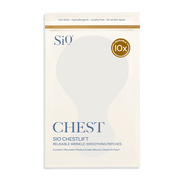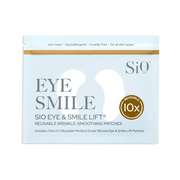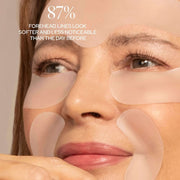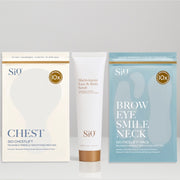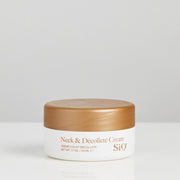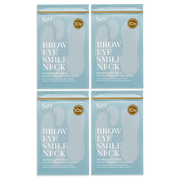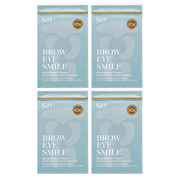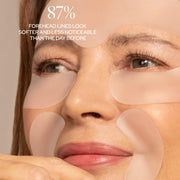Do Silicone Patches Work? Demystifying the Wrinkle-Smoothing Trend

This article has been medically reviewed by Dr. Dendy Engelman, Board-certified Dermatologist.
Many of us aspire to smooth, supple skin in every stage of life. But, 33% of young people, 87.8% of middle-aged individuals, and 100% of older adults experience wrinkles, making them a widespread (if not inevitable) cosmetic concern.
Could silicone patches be the solution we’ve all been searching for?
Silicone patches are one of the skincare industry’s most recent darlings, steadily gaining popularity (and becoming one of TikTok’s favorite Botox alternatives) over the past several years. For wrinkles and scarring, silicone patches promise to be a safe, effective at-home solution. But, is this hype backed up by genuine results?
In this article, we’ll address the questions surrounding silicone patches’ effectiveness and whether you can count on them to safely smooth away wrinkles.
The Science Behind Silicone Patches
Let’s get right to it: Do silicone patches work, and if so, what’s the science behind them?
Silicone patches for wrinkles and scarring are made of medical-grade silicone. When this material is placed on the skin’s surface, it forms a microclimate that draws moisture from the skin’s deeper layers into the epidermis (in a process medically known as occlusion). The microclimate is also rich in oxygen, creating a healing environment for the skin.
In providing a protective layer, silicone patches prevent water loss from the skin. This, along with the process of occlusion, leads to plumper, smoother skin within a few hours.
According to Dr. Dendy Engelman, celebrity dermatologist and SiO Beauty’s medical advisor, “These patches correct existing wrinkles and prevent new wrinkles from forming over time.”
Silicone Patches for Wrinkles: Before and After
To better understand how this skincare marvel works, let’s take a look at silicone patches before and after images:


To accurately demonstrate the results that you can achieve with silicone patches, these images have not been retouched or edited.
Do Silicone Wrinkle Patches Work?
Now that we understand the science behind silicone patches, let’s hone in on their particular benefits for wrinkles.
Silicone patches have become one of today’s most talked-about alternatives to Botox injections for wrinkles. While they work in different ways (Botox blocks facial muscle contractions to keep skin smooth), these treatments may provide similar results. Remarkably, silicone patches do so without the need for injections or dermatologist appointments.
The occlusion process detailed above is the primary reason behind silicone’s wrinkle-busting benefits. By drawing moisture to the skin’s surface, silicone patches create a plump, rejuvenated appearance. But, there’s another reason to reach for these patches to smooth stubborn lines: they keep the skin from creasing in facial expressions.
Expression Lines: Do Silicone Patches Work for Wrinkles Long-Term?
Silicone patches hold the skin in place, preventing creasing from facial expressions. Worn consistently, this can slow the development of expression lines, like frown lines and crow’s feet. Given that repetitive facial expressions can create deep grooves under the skin’s surface, silicone patches can act as a proactive solution for skin aging.
However, the skin-smoothing effects of silicone patches don’t last all day. The patches can only prevent creasing while you’re wearing them (typically overnight). Additionally, your skin’s water content will slowly return to normal after you remove the patches, at which point the plumping effect may disappear.
For long-term results from silicone patches, it’s important to wear them at least 3 to 4 nights per week. This will preserve your skin’s moisture content while preventing facial creasing.
Do Silicone Patches Boost Collagen Production?
If you’ve read up on anti-aging skincare, you’ve probably heard of collagen. Collagen is an essential protein that your body produces to strengthen your skin, bones, muscles, and connective tissues. But, collagen production gradually declines over time, contributing to the thinning, sagging appearance of aging skin.
Silicone patches are thought to boost collagen production when they’re used long-term. This comes down to the healing microclimate created by medical-grade silicone, which increases blood flow to the skin. Blood flow supports collagen production and your skin’s natural healing process.
Nonetheless, increased collagen isn’t the primary anti-aging benefit of silicone patches (that would be occlusion!). So, your dermatologist may still recommend applying a retinoid (on nights you’re not wearing the patches) to ramp up collagen levels, especially if you’re looking to fade existing wrinkles.
Do Wrinkle Patches Work? The Experts Weigh In.
Silicone wrinkle patches are backed by expert dermatologists and extensive clinical research.
In dermatologist-approved clinical trials from Clinical Research Lab and BioScreen, SiO silicone patches provided the following results:
- 87% of participants said their forehead lines appeared softer and less noticeable than the day before.
- 84% of participants said their skin moisture was replenished after 1 night.
- 84% of participants said they would use SiO patches instead of getting a medical procedure, such as injectables, laser treatments, or fillers.
According to Dr. Engelman, “For patients that are hesitant to use injectables, such as Botox, that prevent wrinkles, SiO Beauty patches are the closest, most effective at-home alternative solution. These patches correct existing wrinkles and prevent new wrinkles from forming over time.”
Side Effects: Silicone Patches vs. Botox
We’ve established that silicone patches do work as a viable Botox alternative. But, to paint a more vivid picture, let’s review how the side effects of these skincare treatments differ.
The most common side effect of silicone patches is slight redness upon removal. This results from increased blood flow to the skin, and it typically goes away within a few minutes. Additionally, individuals with a sensitivity to adhesives or silicones may experience slight redness or irritation.
If you’re not sure whether you have an adhesive or silicone sensitivity, we recommend doing a test of the patch on a small area of skin.
Botox, on the other hand, involves injecting a neurotoxin beneath the skin’s surface. This process can lead to various side effects, including:
- Pain, bruising, or swelling at the injection site
- Headache
- Dry or watery eyes
- Droopy eyelids
- Dizziness
- Mild difficulty swallowing
To minimize the risk of side effects from Botox, only receive the injections from a licensed, qualified medical professional.
Do Silicone Patches Work for Scars?
Silicone (in both patch and topical gel form) was originally used for scarring before being applied to wrinkles.
Through occlusion, silicone patches create an ideal environment for scarred skin to heal. Rich in oxygen and moisture, this environment gradually softens and evens out scarring. Plus, silicone patches increase blood flow to the skin – blood carries oxygen and healing nutrients that can help heal scarred skin.
Silicone patches also reduce the production of fibroblasts, the building blocks of scar tissue. This, along with the silicone’s deeply hydrating properties, helps smooth and flatten scars.
According to clinical research, topical silicone gel products, including adhesive silicone patches, are globally considered a first-line treatment for scar management. This research notes that silicone draws moisture to the scar site and prevents scar-related cell overactivity.
How Do Silicone Patches Work for Different Types of Scars?
Between acne scarring, hypertrophic scars, and simple fine-line scarring from cuts, scars can differ significantly. Are silicone patches effective for all of them?
Hypertrophic scars are raised and red, resulting from excess collagen production. They can be caused by any type of trauma to the skin, like a cut, burn, surgical incision, or even acne. Research indicates that silicone patches can effectively flatten and reduce hypertrophic scars.
There’s limited research to support the benefits of silicone patches for pitted acne scars (also known as atrophic scars). While a patch is unlikely to fully raise a pitted scar, it may give the skin a plumper, smoother appearance, making the scar less noticeable. However, further research is required to confirm this.
How Long to Use Silicone Patches for Scars
To effectively flatten and fade scars, you should use silicone for around 3 to 4 months (or longer!) consistently. During this period, apply the patches before bed, at least 3 to 5 nights per week. While this may seem like a long time, untreated scars take much longer to fade.
While using silicone patches for scars at night, don’t forget to apply (and reapply) SPF during the day. The sun’s UV rays can darken scars, undoing your patches’ hard work.
Do Silicone Patches Work: Addressing Common Concerns
We’re here to answer all of your pressing silicone patch questions.
It takes just one use for silicone patches to soften wrinkles and visibly smooth the skin. It can take a few months of consistent use to notice longer-lasting results.
Silicone patches are effective for all skin types, including sensitive skin.
Silicone patches help with loose skin by plumping and deeply hydrating the skin. This gives loose skin a firmer, more youthful appearance.
No, you don’t use moisturizer under silicone patches. Silicone patches should be applied to clean, completely dry skin. Don’t apply any creams, serums, or other topical products before applying a silicone patch.
Yes, you should sleep with silicone patches. This is the most convenient time to wear the patches for many people, and they’ll keep your skin from creasing while you sleep. Additionally, by sleeping with silicone patches, you can wake up with smoother, plumper skin in the morning.
You can use silicone patches for up to 8 hours per 24-hour period.
Silicone patches can work for stretch marks by increasing collagen production and reducing discoloration.
Silicone patches can reduce the appearance of deep wrinkles, especially when they’re used consistently over time.
Wrap-Up: Smoother, Plumper Skin with Silicone Patches
We’re happy to report that silicone patches noticeably improve wrinkles and scarring by drawing moisture into the skin’s outermost layer. Increased blood flow, skin immobilization, and a collagen boost further support these results.
To make the most of silicone patches in your skincare routine, make sure to apply them to dry, clean skin. For the best results, use them consistently, and trade out your SiO patches after 10 uses. With patches for forehead lines, eye wrinkles, smile wrinkles, neck, and decolletage, we’re sure you’ll find patches to suit your long-term skin goals!
If you have more specific skin concerns, consult with a dermatologist in your area for a personalized treatment plan.



